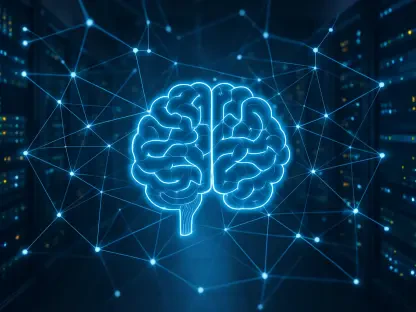In today’s rapidly evolving world, artificial intelligence transcends traditional boundaries, standing at the forefront of technological innovation amid global challenges. The sphere of healthcare is particularly influenced by AI’s potential to redefine methodologies in diagnosis and treatment, with companies like Microsoft pioneering this transformation. By developing the MAI-DxO, Microsoft introduces an AI-driven tool with a diagnostic accuracy that promises revolutionary change. Boasting an 85% correct diagnosis rate on complex cases from the New England Journal of Medicine, this mark is significantly higher than the 20% accuracy achieved by seasoned human physicians during similar tests. As healthcare costs soar to unprecedented levels, the prospect of AI-based diagnostics reaching such accuracy signifies a profound shift towards enhanced healthcare efficiency and precision at reduced expenses. However, the question persists: can AI genuinely revolutionize medical diagnostics and cut costs across diverse healthcare settings while overcoming practical and ethical challenges associated with its implementation?
Accuracy and Efficiency in Diagnosing Complex Conditions
The promise of Microsoft’s MAI-DxO as a powerful diagnostic tool lies not only in its incredible accuracy but also in its ability to address complex medical conditions that traditional diagnostic practices might struggle with. In scenarios involving multifaceted health cases, the tool demonstrated impressive diagnostic prowess, proving to be a vital ally for healthcare professionals. By integrating extensive knowledge drawn from specialists and general practitioners, MAI-DxO offers a unified approach to diagnosing intricate health issues. This collaborative essence emerges as a hallmark of AI’s transformative potential in medicine, striving to overcome the typical siloing that characterizes traditional medical practice. However, its application in more common and straightforward medical conditions has yet to be rigorously explored, leaving room for further exploration and validation. By doing so, AI aims not just to provide competent assistance in severe cases but to be equally effective across the full spectrum of medical diagnostics, pushing boundaries beyond current limitations.
Aside from accuracy, MAI-DxO brings forward the notion of efficiency—streamlining diagnostics while concurrently reducing unnecessary procedures. By diminishing the frequency of superfluous tests and effectively managing diagnostic processes, healthcare systems experience decreased financial burdens. Such advancements lead to improved patient care, shorter wait times for diagnosis through value-based strategies, and increased access to essential resources worldwide. While the discussion emphasizes AI’s potential impact, real-world scenarios influenced by varying health insurance coverages pose significant challenges. Fortunately, the orchestrator function of the AI tool allows MAI-DxO to simulate these scenarios and optimize healthcare decisions under those constraints. Aside from technical prowess, the broader scope of affecting healthcare systems necessitates comprehensive analysis regarding AI’s influence on disparate insurance landscapes and how it harmonizes costs while maintaining excellence in patient care.
Challenges of Implementation and Future Prospects
Despite promising results, the implementation of AI diagnostics like Microsoft’s MAI-DxO involves numerous hurdles that merit closer examination. The overestimation of AI capabilities based on standardized tests poses a significant barrier, chiefly because these tests favor rote memorization over intricate reasoning. This bias can affect AI systems by shedding light on their limitations when encountered with unclear circumstances—a reality even the company acknowledges. It accentuates the necessity for transposing the tool’s capabilities to real-life medical scenarios. Additionally, traditional medical professionals operated in isolated settings during AI testing, lacking collaborative tools commonplace in their everyday practice, which may skew outcomes. Still, the potential of AI becomes evident when contextualized within real-world environments, suggesting promising horizons for AI-enabled healthcare transformations.
The tool remains at the prototype stage, with further testing essential to validating its safety, reliability, and efficacy before venturing into commercial landscapes. Microsoft forecasts a timeline within the next decade where such AI systems could alleviate global healthcare workloads, manifesting as a transformative force backed by continual technological strides. The future anticipates these advancements sparking pivotal shifts, embedding AI into the foundation of medical practice. A transformative vision extends beyond mere mechanics to include a nuanced understanding of ethical considerations inherent in AI applications, underscoring the strategic importance of active discourse encompassing policy-making, patient privacy, and the balance between human accountability and AI autonomy.
Moving Forward: AI’s Role in Healthcare Evolution
In today’s fast-paced world, artificial intelligence is breaking traditional barriers and driving technological advances, especially during global challenges. AI’s influence is particularly notable in healthcare, where it holds the potential to transform diagnosis and treatment techniques. Microsoft is a leader in this change, developing MAI-DxO, an AI tool with impressive diagnostic precision. This tool boasts an 85% accuracy rate for complex cases from the New England Journal of Medicine, far outperforming human physicians’ traditional 20% accuracy in similar scenarios. As healthcare costs continue to rise, AI-based diagnostics promise a shift towards greater precision and efficiency, potentially lowering expenses. However, the ongoing question remains whether AI can truly transform medical diagnostics and reduce costs across various healthcare environments while addressing practical and ethical concerns in its application. Microsoft and others in the field must tackle these challenges to ensure AI’s potential is fully realized.









